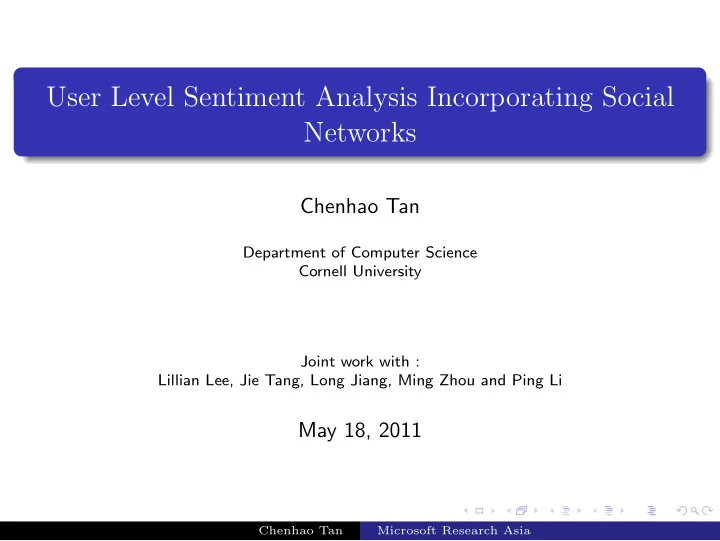

User Level Sentiment Analysis Incorporating Social Networks Chenhao Tan Department of Computer Science Cornell University Joint work with : Lillian Lee, Jie Tang, Long Jiang, Ming Zhou and Ping Li May 18, 2011 Chenhao Tan Microsoft Research Asia
Outline 1 Motivation 2 Problem Setting in Twitter 3 Data Collection 4 Observation 5 Model 6 Approach 7 Experiment 8 Conclusion Chenhao Tan Microsoft Research Asia
Motivation User-level sentiment analysis Network information Accessibility Homophily or Attention Chenhao Tan Microsoft Research Asia
Twitter as the basis Text information: Tweets Network information Follow Network @ Network ⋄ directed ⋄ mutual Chenhao Tan Microsoft Research Asia
Semi-supervised Learning in Twitter Hard to get full labels Given a graph and labels of some nodes in the graph, try to classify the other users in the graph Chenhao Tan Microsoft Research Asia
Data Collection Traditional Annotation by Tweets Chenhao Tan Microsoft Research Asia
Data Collection Failed Traditional Annotation by Tweets Chenhao Tan Microsoft Research Asia
Data Collection Failed Traditional Annotation by Tweets User Biographical Information Chenhao Tan Microsoft Research Asia
Final Data Set 1, 414, 340 users 1, 414, 211 user profiles 480, 435, 500 tweets 274, 644, 047 t-follow edges 58, 387, 964 @-edges Chenhao Tan Microsoft Research Asia
Sharing Label conditioned on being connected Probability that two users have the same label, conditioned on whether or not they are connected Chenhao Tan Microsoft Research Asia
Connectedness conditioned on labels Probability that two users are connected, conditioned on whether or not they have the same label Chenhao Tan Microsoft Research Asia
Model Framework User-Tweet Factor w labeled � | tweet vi | y i = k, y t = l w unlabeled f k,l ( y i , y t ) = y i = k, y t = l | tweet vi | 0 otherwise User-User Factor � w relation | Neighbors vi | y i = k, y j = l h k,l ( y i , y j ) = 0 Objective Function � � � log P ( Y ) = � µ k,l f k,l ( y v i , y t )+ v i ∈ V t ∈ tweet vi ,k,l � �� λ k,l h k,l ( y v i , y v j ) v j ∈ Neighbors vi ,k,l − log Z Chenhao Tan Microsoft Research Asia
Approach Parameter Estimation Direct estimation from simple statistics SampleRank Inference loopy belief propagation Chenhao Tan Microsoft Research Asia
Methods Training set: 50 positive users and 50 negative users the others for testing Labels of Tweets SpecificSVM Labels of Users Majority Vote HGM-NoLearning HGM-Learning Chenhao Tan Microsoft Research Asia
Case Study � � � � � � � � � � � � ����� ����� ����� � � � � � � � � � (a) Ground Truth (b) Text-Only Approach (c) Our algorithm Chenhao Tan Microsoft Research Asia
Case Study Sample tweets of users classified correctly only with network information Chenhao Tan Microsoft Research Asia
Overall Performance Beat Baseline! Follow better than @ Directed better than Undirected NoLearning same with Learning Chenhao Tan Microsoft Research Asia
Performance Per Topic Sparseness of graph Size of graph or #Tweets per user SVM Classifier Performance Chenhao Tan Microsoft Research Asia
Adding More Unlabeled Data Learning better than NoLearning Chenhao Tan Microsoft Research Asia
Conclusion Empirical analyses on the correlation of networks and sentiment Propose a heterogeneous graphical model Validate the effectiveness of incorporating network information Chenhao Tan Microsoft Research Asia
Future Work More data sets Better models and semi-supervised learning algorithms Find the helpful parts of networks Build a theory of why and how users correlate on different topics in different kinds of networks Chenhao Tan Microsoft Research Asia
The End Thank you! Questions? Chenhao Tan Microsoft Research Asia
Recommend
More recommend